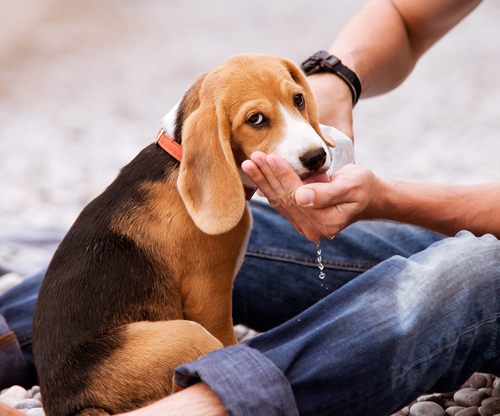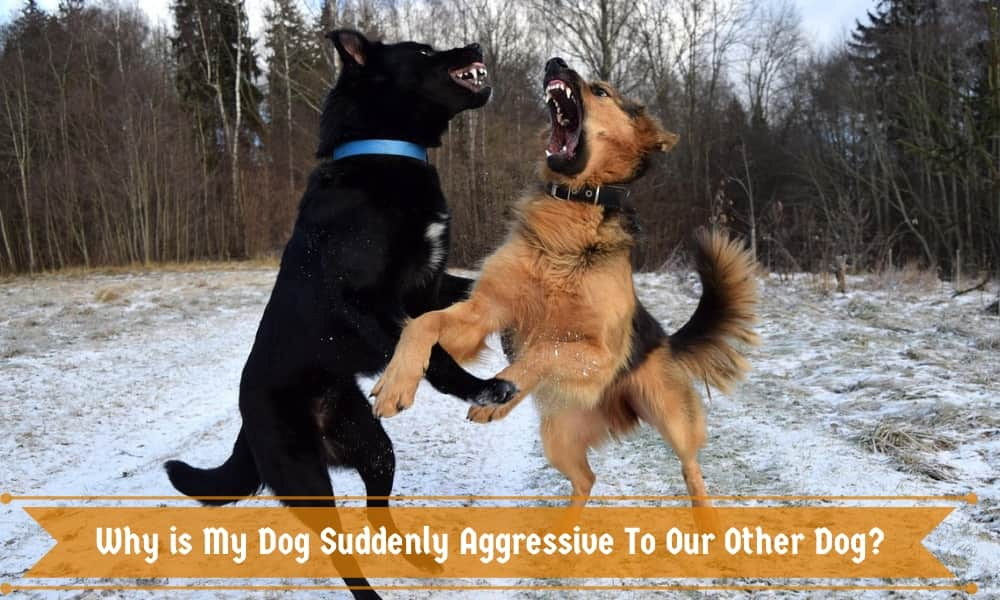
The worst has happened – your usually sweet, friendly dog has become aggressive to your other dog. It has suddenly snapped in aggression, growling and lunging, baring its teeth. How could this have possibly happened? What changed overnight for your dog to start acting this way?
It can be difficult to know what to do in this situation. You don’t want to make any rash decisions – this is a member of your family we’re talking about – but you know that you have to do something. Dogs suddenly being aggressive can be dangerous for everyone and result in injuries to other dogs and humans. Making sure you find the cause of aggression and correcting it as soon as possible is important.
Contents
Why Do Dogs Fight?
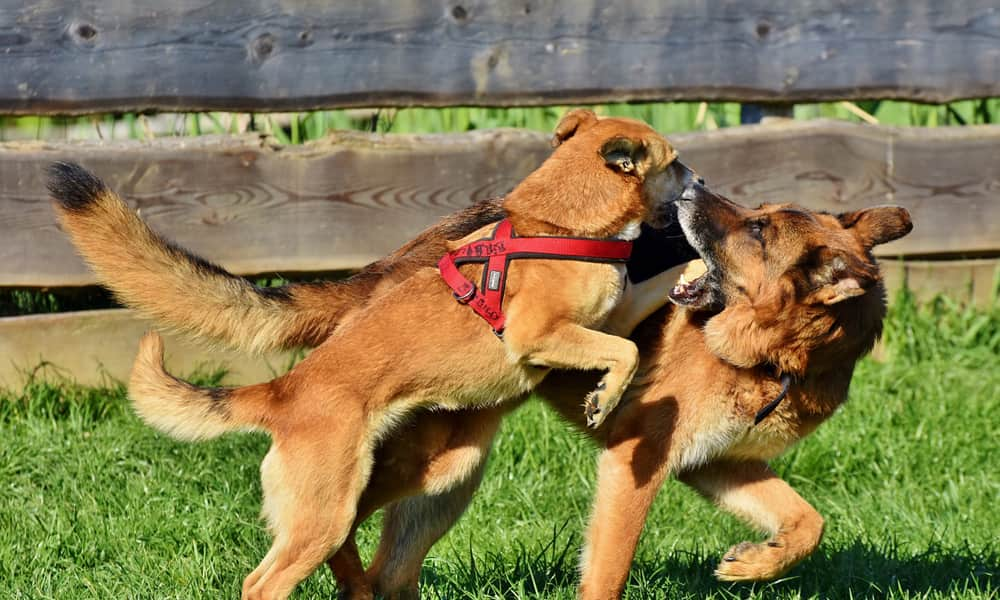
Before we get into specific causes of aggression, it helps to understand why dogs attack other dogs in the first place. You’d think they’d recognize the other dog as a harmless playmate and family member. Is it simply a case of sibling rivalry gone too far? Unfortunately, that’s not the case. Aggression is a result of a dog reaching its stress threshold. Something has built up within the dog, most likely over time, and caused it to lash out in aggression. At this point, the dog is most likely to lash out towards other canines, and unfortunately, the other dogs in your household are first on the list.
When you sense that tensions are starting to increase between your dogs, look for possible stressors that have appeared in their environment. Likely, something has recently occurred to add stress – it may even something as simple as an undesirable change in weather. Maybe your pup isn’t a fan of bitterly cold weather and the snow that comes along with it. This could cause tensions to increase as it knows that it’s going to be forced outside to use the bathroom. Bitterly cold weather could also result in a decrease in exercise because there aren’t as many opportunities to get outside. This also increases tension as exercise is one of the best ways of relieving stress in pups.
These kinds of tensions may not be as obvious as your pups fighting over a toy or a bone. Think about both immediate triggers that may be less obvious and could be building up over time. The next step is to remove these triggers or put a plan in place to resolve them as best you can.
Why Do Dogs Show Aggression?
Narrowing down the triggers that are making your dog act out aggressively is essential to stopping this behavior. There are many reasons why your sweet, docile, furry best friend may have started acting out aggressively towards your other dog, including:
● Illness/Injury
Illness and injury are two of the first things you should examine if your dog suddenly starts becoming aggressive. It may be in pain and doesn’t know how to deal with it in any other way. Your dog may start growling or snapping because another pup got too close to a certain part of its body that’s hurting or it may just not be feeling well. If you suspect this may be a possibility, get them examined by a vet immediately.
Other illnesses that do not necessarily cause pain that can lead to a sudden change in your pup’s behavior, especially as it gets older. Cognitive changes occur. In some cases, tumors or diseases may put pressure on the brain, resulting in an aggressive change in behavior.
● Fear
Fear is another common sign of aggression in dogs. A dog may become aggressive if it senses that it’s trapped or in danger. That said, it’s unlikely that your perfectly adjusted, the docile dog will become fearful around a dog it’s known for years. If your dog is a rescue, there is an increased chance that a particular incident caused it to become fearful and aggressive, even if they haven’t shown any aggression before.
A dog may have been bitten by another dog, hit by a previous owner, or experienced another traumatic event. It may have not been socialized as a puppy and doesn’t know how to handle certain situations. Making sure you’re aware of any trauma that the dog could have been exposed to before you became their owner is extremely helpful to avoid potential aggression.
● Possessiveness/Resource Guarding
Possession aggressiveness is a kind of aggression that you’ve likely already seen – it’s not uncommon for a sweet and docile dog to show aggression over a toy or bone that it’s really enjoying. The dog usually only exhibits this sort of aggression in the form of growling or snapping to give the warning to stay away.
Possessiveness largely depends on the level of value that the dog places on the object. If it’s a toy that it’s chewed dozens of times and it’s just passively playing with, it may not mind it being removed. If it’s a new toy or a particular treat that the dog is enjoying, it may snap at anyone who tries to take it away, dog or human.
● Frustration
Frustration aggression is often caused by a dog not getting enough exercise or socialization. If a dog is constantly chained up or restrained and only has a small area to run around in, frustration may start to build. It wants to move around freely and gets stressed when it doesn’t get what it wants. This is not a happy life for a dog and it may start to get aggressive, especially when what it wants is held tantalizingly out of reach. When it does get contact with its owner or another dog, it may act out aggressively. This is because of the level of frustration and unhappiness it’s reached as the result of being restrained so often.
● Establishing Dominance
Dogs may show aggression to establish dominance, especially towards other dogs in the household. This most commonly occurs when a second dog comes into the household and the first dog feels as if its position is being challenged. It wants to show that it’s still the alpha dog and that the new dog is coming into its space. This may present itself in the form of growling, snapping, and biting.
How can I stop my dogs from fighting?
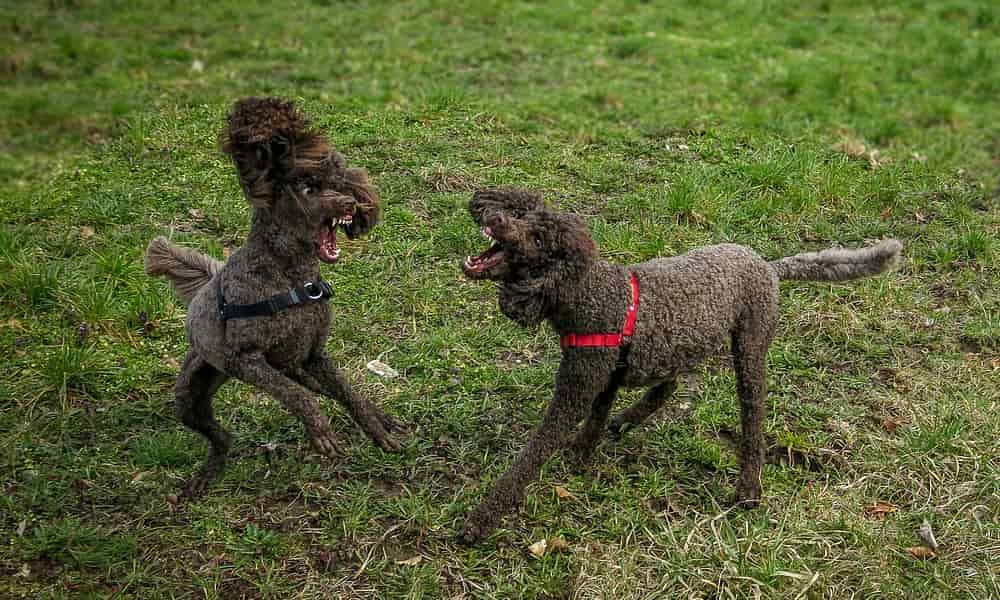
The first step in correcting your dog’s aggressive behavior is to recognize the stressors that are causing it. Quickly eliminate the possibility that your dog may be acting out in aggression due to an injury or illness by taking it to the vet. If you are certain that your dog does not have an underlying medical condition, there are steps you can take to hopefully correct this behavior:
1. Removing Your Dog’s Stress Triggers
Removing your dog’s stress triggers is easy if they’re within your own home. Once you’ve looked for them and are committed to figuring out what makes your dog tick, stress triggers should become fairly obvious to you. Common stress triggers that can be easily removed include:
- Choke, prong, or shock collars
- Physical or harsh verbal punishment or corrections
- Treatable medical conditions
It’s true that you can’t get rid of all of your dog’s stressors because they aren’t all in your control. That said, obvious stressors can be dealt with in a way that does not stress out your dog. When it comes to electronic corrective devices or any sort of harsh punishment, reevaluating what you can do to correct your pup’s behavior may be important in reducing their stress load.
2. Address What Stressors You Can Live With
When going through the list of your pup’s possible stressors, it’s important to think about which ones you think it can live with. These include stressors that don’t happen frequently and those that elicit a mild response. If your pup is naturally on the nervous side, odds are you won’t be able to avoid every possible stressor and you may not have enough time in your own schedule to address them all.
There are certain behaviors that you should not discourage that are considered fun stressors. These include harmless roughhousing with your other dog or chasing a squirrel around the yard. Although you may see these kinds of stressors as annoying, they may be letting out pent-up stress in your pup.
3. Avoidance of Stress Triggers
Sometimes you won’t be able to remove all serious stress triggers, even in your own home. It’s at this point that you’re going to have to learn to avoid them. You may think that this doesn’t solve everything but it’s likely that your dog will outgrow some of these behaviors. For example, if your dog doesn’t like your other dog near its bowl while they eat dinner, start feeding them in separate areas. It is not necessary to keep pushing something that is clearly a stress trigger to your dog just because you think they should be able to eat beside each other in peace. Some dogs are territorial around their food and it isn’t because they’re bad dogs. Your other dog will eventually learn to leave your dog alone while they eat their food. To slowly make improvements when it comes to guarding, gradually decrease the distance between your dogs when they eat. Start by feeding them in separate rooms and work toward feeding them in the same room over time. You don’t need to gradually decrease the space between them until they’re touching but slowly allow your dog to understand that its housemate is not a threat to its meal.
4. Give Them Plenty of Exercise
Think about how much less stressed you feel after a workout. If you started off your workout with some pent-up tension, odds are it slowly started to melt away, right? Well, it’s the same with dogs. Exercise works phenomenally well in reducing overall tension in dogs and uses the excess energy that is adding fuel to your pup’s aggressive behavior. Just like in humans, exercise naturally releases endorphins and gives it a sense of calm and wellbeing. As a general rule, if your dog is acting out, there’s a good chance that it’s not being well exercised. An exercised and tired out dog is a well-behaved dog so get your hiking boots out and hit the trails with your pup.
5. Feed Them A High-Quality Diet
Poor nutrition can have an impact on a dog’s behavior and cause it to act out, just as in humans. Specifically, low-quality protein can have this effect on a pup and messes with its ability to use its natural supply of serotonin while discouraging production. Healthy levels of serotonin are necessary to regulate both mood and sleep and can affect your pup’s memory and its ability to learn. Making sure that it’s set up for success right from their morning meal could do wonders for keeping your pup in the right frame of mind.
6. Keep Up with Basic Training and Routine
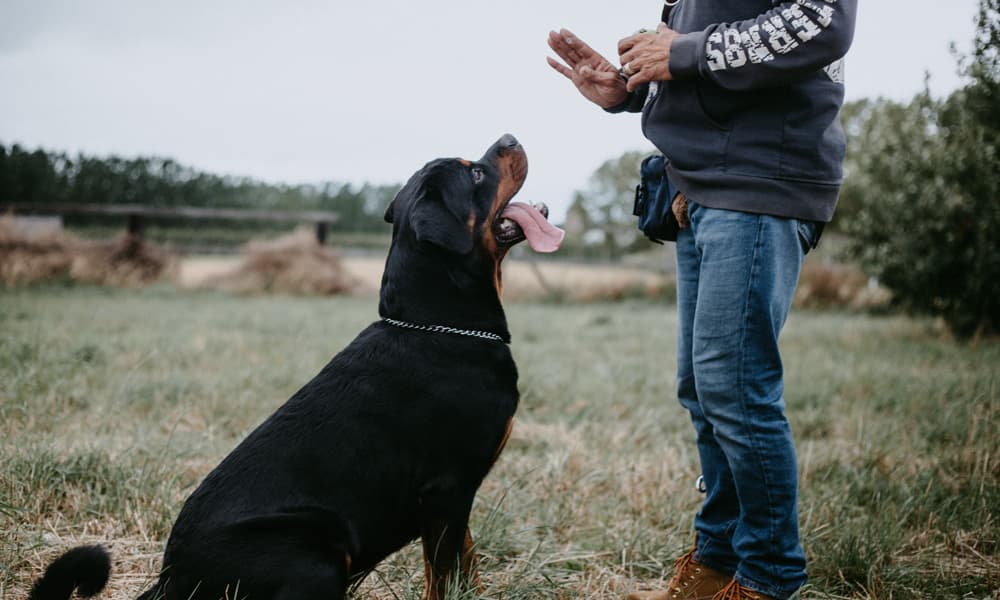
Making sure your dog knows basic commands helps it develop a sense of routine and encourages communication. Whether they show it or not, dogs heavily respect routine and respond quite well to it. It makes them feel like they’re in a controlled environment where they know what’s coming next. Predictability is a great thing for dogs and provides them with both structure and consistency which is what they need. If your dog is already prone to stress, providing a rigid routine will work wonders in reducing it – if your dog knows what’s coming next and enjoys its daily routine, there’s nothing to be stressed about.
7. Canine Massage
Just as with humans, touch can be calming and soothing. If your pup is in a situation that stresses it out, try taking its mind off of it with a massage. This may sound silly but it can definitely help reduce anxiety and may also help the dog realize that the situation really isn’t so stressful at all, changing their association with the stressor from negative to positive. Consider adding a high-quality lavender oil into a diffuser and having this on in the room while you massage your pup. Once your pup starts to associate this scent of lavender with relaxation, you can use this to your advantage. Start adding a few drops of it onto a bandana around its neck or on the bedding in its crate. The smell alone may immediately begin to calm it down.
8. Stress-Reducing Music
Believe it or not, there is stress-reducing music for dogs. Classical piano music tends to work best and has been proven to encourage calm behavior by reducing their heart rate. Stress-reducing music for dogs can be found on CD or be streamed or downloaded from iTunes or Spotify. Consider leaving calming music on when your dog is in a situation that triggers them – this is also great for dogs who suffer from anxiety when left alone.
9. Anxiety Wrap/Thunder Shirt
Anxiety wraps or the “Thunder Shirt” can be a great way of making a dog feel more secure. These focus on maintaining pressure which mimics the feeling of being swaddled and held. and have proven effective in a variety of situations for dogs. They are especially popular for dogs that have separation anxiety or those that are provoked by loud noises (e.g. during a thunderstorm).
Last Resorts for Aggression Between Dogs
Unfortunately, it may get to a point where the situation is serious and beyond what you can handle on your own. It may become unsafe for your other dog as well as you and your family members. Owners have been bitten while trying to break up a serious fight between their dogs. In situations like this, both your and the dog’s quality of life becomes severely damaged and the tension creates an undesirable living environment. When it comes to the last resorts for correcting aggressive dog behavior, the following should be considered:
1. Hiring a Qualified Positive Behavior Consultant
If you and your family are unable to cope with the situation, finding a qualified dog behavior consultant that can give you advice about the situation is preferable. They can take a look at your dog’s behavior from a professional standpoint and give you a personalized plan. They do this by coming into your home and observing the situation firsthand to give you advice on how to best go about making changes and how to keep everyone safe.
2. Consult with a Veterinarian
Even if your vet has cleared your pup for any physical or mental illnesses that may be resulting in aggression, there may be something else that they can suggest. Your vet may recommend natural supplements to help your dog’s behavior or even psychotropic behavior modification drugs that have the possibility of encouraging your pup’s brain to be more receptive to your behavior modification efforts.
3. Rehoming Your Dog
Although heartbreaking and an absolute last result, some dogs just aren’t able to get along. There are many dogs out who have to be the only dog in their household. If this is the case, rehoming either your dog or the dog that they cannot get along with maybe necessary for everyone’s sanity and safety. You don’t want anyone in your household to constantly be living in fear. No human or animal should have to live that way.
4. A Lifetime of Constant Management
If you are truly up for it, keeping your dogs separated at all times is certainly a solution – although, not a desirable one by any means. Closing doors and using gates throughout the house may be necessary to keep your dogs separated at all times. Those who choose to attempt this method generally don’t attempt it for too long. Management has an incredibly high risk of failure, especially if there are children in the home. The odds that someone is going to leave a door open or a gate unlatched at some point are high, exposing the dogs to a high conflict situation. Neither of your pups is going to have a great quality of life as one of them will always need to be shut away so constant separation is generally not a desirable way to go.
When it comes to dealing with a dog that has suddenly become aggressive towards your other beloved pup, the situation can be incredibly scary and frustrating. It is important to admit when you’ve done everything you can and acknowledge that the safety of everyone involved comes first. There are many steps you can and should take before throwing in the towel – it may be as simple as lowering your pup’s daily stress load. Remember, your dog is your best friend – it wouldn’t give up on you, so don’t give up on it.
I grew up in a household that was filled with animals. I believe that my fate as a dog-loving person was sealed in early childhood since my parents owned several dogs of varying sizes and breeds. There was no choice but to take care of and learn about dog habits and the best animal care practices — otherwise, I’d be clueless about how to go about the creatures I was surrounded by day and night.
As a life-long puppy lover, I know a thing or two about dogs and how to go about caring for them in the best way possible. Although I’m not a professionally trained dog behaviorist, trainer, or veterinarian, all of my knowledge and experience with canines comes from a place of love and a deep-rooted passion for dogs and animals in general.
Seeing as dogs kept me company throughout every stage of my life, I decided to follow a different path in my academic life and obtained a Bachelor’s and Master’s degrees in Marketing Management and Digital Advertising, which ultimately allowed me to combine my professional training and personal experience by creating the ultimate dog lover’s resource website! Along with my husband, Dave, I run MySweetPuppy for like-minded dog lovers who want to have a single, clear, and reliable information source about anything and everything related to dogs and their well-being.



